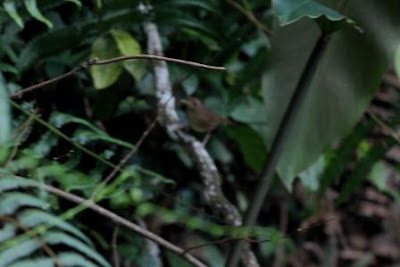After a two-year absence from birding at Awana OPH, i called Mr CY Tan, a veteran hiker, mountaineer and nature lover cum birder to ask him whether he would be interested to join me for a half-day birding trip. He did not hesitate a second in replying and so off we went on a Sun morning. Awana OPH is located near the township of GohTong Jaya, in the state of Pahang and is only about half way to Genting Highlands. It is said to be about 1000 feet above sea level and i certaintly cherished its cool mountain air.
We had our breakfast at 7.10am and started birding about 7.30am. We initially discovered that the entrance near to the road leading to the main gate was actually "locked" so we did a "U" turn and parked the car near a row of shop lots and started our "morning walk" from there. Thank God that the main gate was opened so it was a good start afterall. The first bird sound which greeted us was the famous repetitive "chonk, chonk, chonk" sound made by a stripped-tit babbler just before the main gate area. Although the call was very close but unfortunately we could not spot the bird as it has probably hidden its self in one of the thick bushes. The next bird we spotted was really unexpected as it was never recorded so high up here before:

Initially we have registered this bird as a "Horsfield Babbler". Dave Bakewell commented that it could probably be a "Lesser Shortwing" which looks like one as well. If its a Horsefield than it could be the first of its kind to be recorded at this place. Wish i had a better lens for a sharper picture.
We did came across many other birds and here are some of them:
A handsome White-Rumped Munia collecting nesting materials.
This is a Lesser Cuckooshrike - a very friendly bird which allows close photography.
This a male Grey-Chinned Minivet. Usually found at a higher altitude than its relative, scarlet minivet. They are usually also found high up in the canopy but this fellow decided to catch some insects at eye level.
These are Chestnut-Capped Laughing Thrush. A very common resident of hill stations. Found at least 4-5 of them along the trail. They must be thriving well here.
Wait a minute is this a Bronze Drongo or a lesser racket-tailed drongo without its streamers? It looks more like a Bronze Drongo.
This is a beautiful female Silver-Breasted Broadbill. It was sitting there rather quietly but somehow we managed to spot it.
Ah this is a Grey-Headed Canary Flycatcher. It was following a bird wave when this photo was taken.
This bird is certainly a star in Awana OPH. This bird was initially registered as a Greater Racket-Tailed Drongo based on its forked tail. After further consultation with the experts and the comment by Dave Bakewell, this bird could just be a "Lesser Racket-Tailed Drongo" !
This is a Purple-Naped Sunbird - it was looking rather curiously at us.
A common Black-Crested Bulbul at its best pose.
This must certaintly be the best of the lots - a male Red Jungle Fowl. It was last recorded at nearby Awana in year 2000. This fellow was actually walking away quite fast and at the same time looking behind to see whether we are following him. Yes indeed we are actually trying to be closed to him. Finally he had enough and flew off into the undergrowth.
We also came across this lovely wild orchid at full bloom. Saw many people took its photo so i decided to do likewise and share it with you. Unfortunately i do not know its scientific name.





